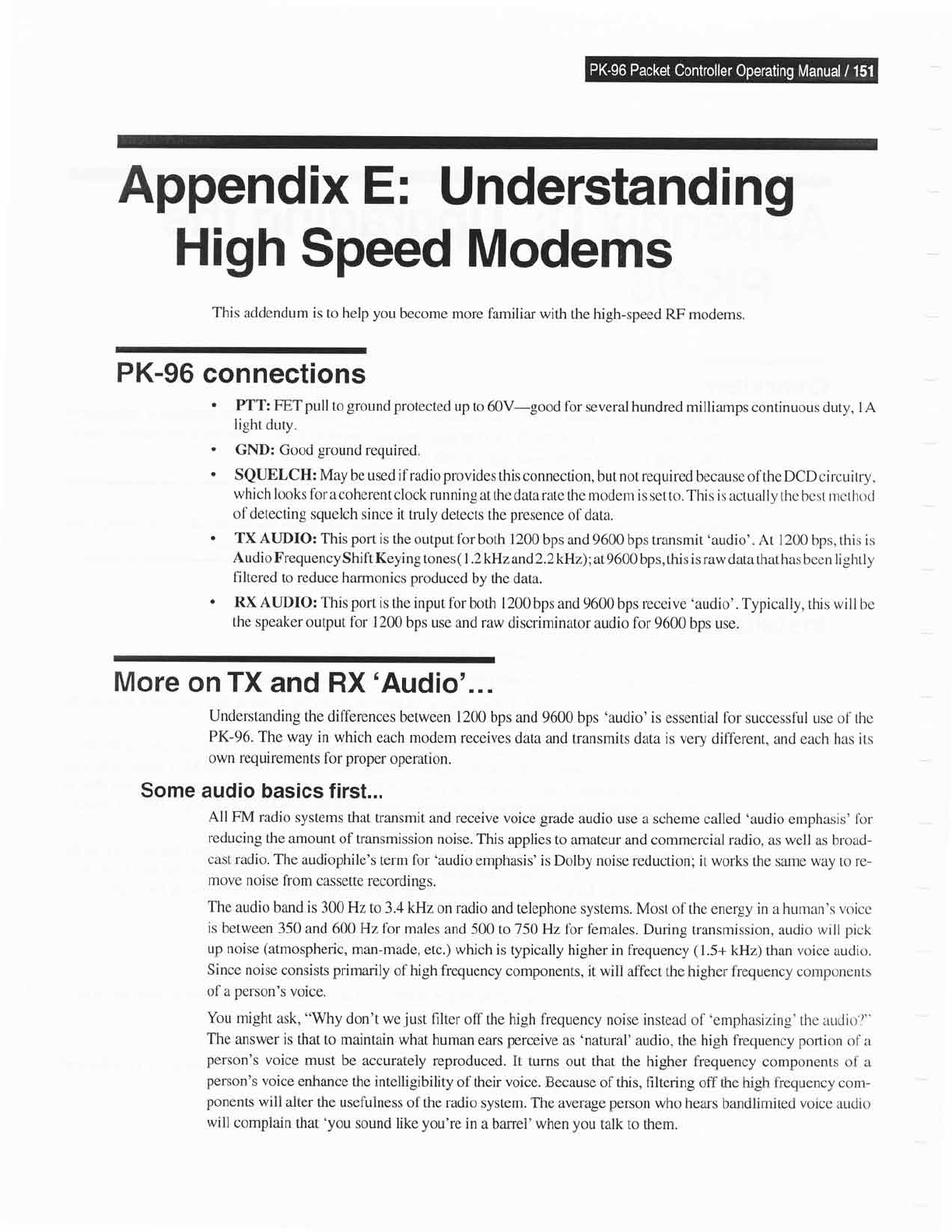Specifications
Table Of Contents

Appendix
E:
Understanding
High
Speed Modems
This
addendum is
to help
you
become more
familiar with
the high-speed RF
modems.
More
on TX
and RX
'Audio'...
Understanding
the differences
between 1200 bps
and 9600 bps
'audio'
is
essential for successf'ul
use of the
PK-96.
The way in
which
each modem receives
data and
transmits data is very
different, and each has its
own
requirements
for
proper
operation.
Some
audio
basics first...
All FM
radio
systems that
transmit and receive
voice
grade
audio use
a
scheme
called
'audio
emphasis' fbr
reducing
the
amount
of transmission noise.
This applies
to amateur
and commercial radio, as well as
broad-
cast
radio.
The
audiophile's
term for
'audio
emphasis'is Dolby
noise reduction;
it
works
the same way to re-
move noise
from
cassette recordings.
The
audio band is
300 Hz to3.4kHz
on radio
and telephone systems. Most
of the energy in a
human's
voicc
is
between 350
and 600 Hz for
males and
500 to'750H2 fbr
f'emales. During transmission,
audio willpick
up noise
(atmospheric,
man-made,
etc.) which is
typically higher in frequency
(
I .5+ kHz) than voice
audio.
Since noise
consists
primarily
of high frequency
components,
it will affect
the
higher frequency
componenrs
of a
person's
voice.
You
might ask,
"Why
don't
we
just
filter
off the high frequency
noise instead
of
'emphasizing'
the audio /"
The
answer is
that to maintain
what human
ears
perceive
as
'natural'
audio,
the
high frequency portion
of a
person's
voice
must
be accurately
reproduced. It
turns out that
the
higher frequency
components
of a
person's
voice
enhance the intelligibility
of
their voice. Because
of
this,
filtering ofr
the
high frequency
com-
ponents
will
alter
the usefulness of the radio
system. The
average
person
who hears
bandlimited voice audio
will
compiain
that 'you
sound like
you're
in a
barrel'when
you
talk to them.
PK-96
connections
PTT: FET
pull
to
ground protected
up to 60V-good for
several hundred
milliamps continuous
duty, lA
light
duty.
GND:
Good
ground
required.
SQUELCH:
May be used if
radio
provides
thisconnection,
butnotrequired because of the DCD circuitry,
which looks
foracoherentclock
running
atthe datarate
the modem is set
to.
This is
actually thc best
rncrhod
of detecting
squelch since it
truly detects the
presence
of
data.
TX AUDIO:
This
port
is the output
fbr both 1200
bps and 9600 bps
transmit
'audio'.
At 1200 bps, this is
AudioFrequencyShiftKeying
tones( 1.2
WlzandZ.2kHz);at9600bps,
this is rawdata
that
has
been lightly
filtered
to reduce
harmonics
produced
by the data.
RX AUDIO:
This
port
is the input
for both 1200
bps and
9600 bps
receive
'audio'.
Typically, this will
be
the
speaker output for
1200 bps
use and raw discriminator
audio for
9600 bps use.










